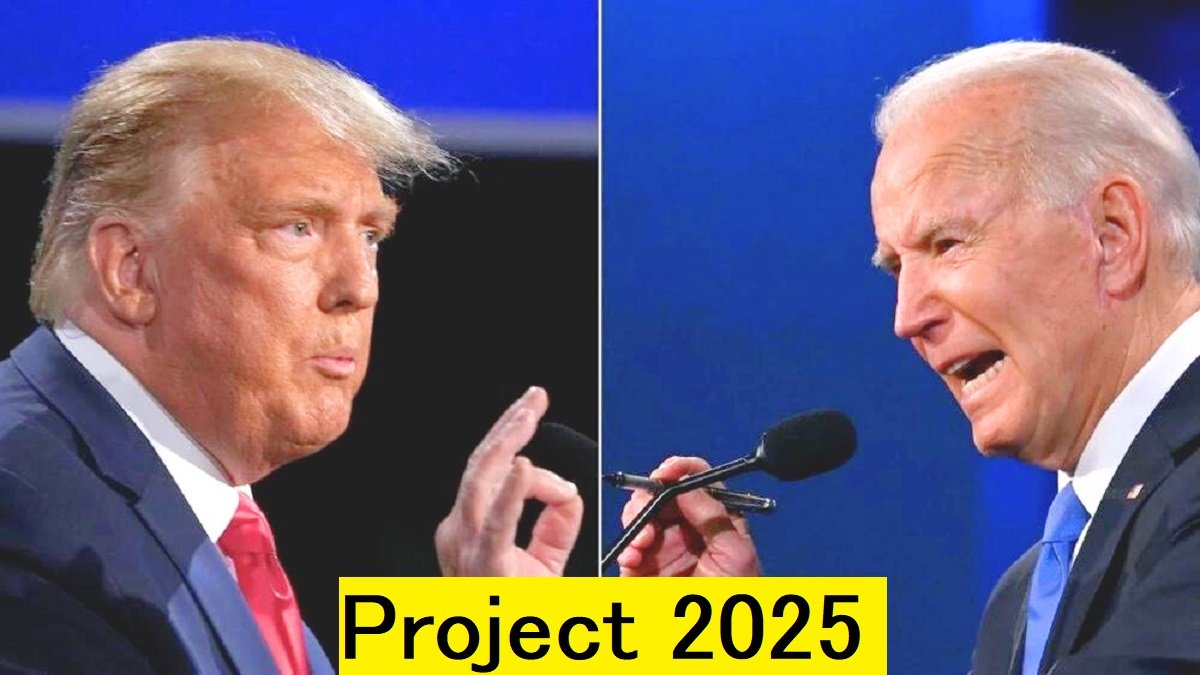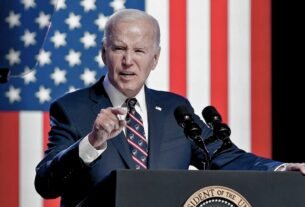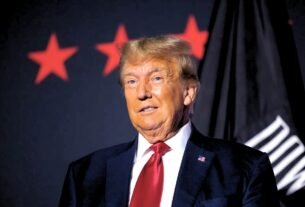One term has come to stand in for all the terrifying things that could happen if Donald Trump were to win a second term as president: Project 2025.
It has been referred to as “dystopian” and “authoritarian.” It’s the TikTok craze. It is viewed by some Democrats as the one thing that could turn around President Joe Biden’s flagging reelection campaign. However, Trump is now absurdly asserting that he has no knowledge of it.
What then is it?
The conservative movement’s precise and comprehensive plan, known as Project 2025, outlines what the next Republican president ought to do with his office and how it intends to go about preparing for its implementation. In essence, it’s an effort to make Trump’s second term far more coordinated and productive than his first.
Project 2025, spearheaded by the right-wing think tank Heritage Foundation and endorsed by over 100 conservative organizations, has presented a comprehensive policy agenda spanning 922-pages, outlining proposals for each federal agency.
It is not a lofty policy agenda full of grandiose but meaningless promises. It was assembled by a number of individuals who held high positions under Trump and is designed to be a list of things the future president’s appointees truly can accomplish. (Project 2025 is also compiling the names of conservative candidates to fill positions during Trump’s second term into a database.)
What does it say, though? Are its suggestions really as horrifying and radical as progressives say they are? And is it actually what Trump would do in the end?
Because Project 2025 covers a wide range of topics (and some assertions regarding its contents are merely untrue), the responses are a little nuanced. I categorize its agenda into three distinct areas:
1) Concentrating power in the presidency: The goal is to give Trump and his nominees greater authority over the executive branch in comparison to permanent, impartial civil service employees—a group he derides as the “deep state.” Opponents worry that this may result in political hacking and the abuse of power. We have every reason to think that Trump will put these ideas into practice because he supports them.
2) Achieving longtime conservative priorities: This includes actions such as cutting regulations, decreasing federal assistance to the impoverished, abandoning attempts to combat climate change, increasing military spending, and so on. Though not particularly novel, these concepts are widely believed by progressives to be awful. Basically, Trump is in favor of each of these. (Project 2025 mainly stays away from adopting strong stances on matters like trade where Trump deviates from the conservative consensus.)
3) Taking a hardline religious-right agenda: The project lays forth rather aggressive plans to limit certain types of contraception coverage and prohibit abortions using federal power. Pornography should even be “outlawed,” and those who distribute it should be “imprisoned,” according to this statement.
The suggestions that Trump could be most leery of are the last ones. He posted on TruthSocial, saying, “Some of the things they’re saying are absolutely ridiculous and abysmal,” though he didn’t name which ones. However, the truth is that they are all significant factors contributing to some of Trump’s most dependable and significant political allies—people he regularly favors with significant appointments. The abortion ideas in particular may very possibly become law if he gives them important positions once more during his second term and fails to control them.
Furthermore, there are a lot of unfounded rumors floating about regarding Project 2025 that don’t really exist (it doesn’t, for example, advocate abolishing no-fault divorce). However, a large portion of its 922 pages do appear to be a rather accurate guide to Trump’s policies if elected.
Who is behind Project 2025? Is it Trump?
The Heritage Foundation is the first chapter in the story of Project 2025. Heritage has positioned itself as the primary think tank for the conservative movement ever since it was founded in the 1970s. Its objective is to drive the Republican Party further to the right so that party officials pay more attention to hardliners and ideologues than to centrists and the establishment of the traditional party.
Heritage accomplishes this in part by formulating and promoting policy recommendations. Additionally, they aim to function as a kind of “administration-in-waiting” should the GOP loses control, having professionals working for them who may be appointed to a newly elected government. In certain respects, Project 2025 is not novel: The ultra-long (and extreme) plans that the Heritage Foundation has been producing outline what the next conservative president ought to do
However, the circumstances are different this time around, partly because of Heritage’s tight relationship with Trump and partly because this is a unique instance of a former president seeking reelection.
If the next president were elected, there would typically be some degree of uncertainty regarding the people he would choose to serve in his administration. However, Trump has been president before, and in that capacity, he made significant use of Heritage appointees. (After his stunning victory in 2016 he had to immediately appoint officials and draft policies; Heritage was ready and waiting.)
Approximately two-thirds of the writers and editors who contributed to the Project 2025 plan were employed by the Trump White House. Among the authors of chapters are HUD Secretary Ben Carson, acting Defense Secretary Chris Miller, deputy chief of staff of the White House, former OMB director Russ Vought, and senior DHS official Ken Cuccinelli. Additionally, John McEntee, the director of people at the White House who removed employees thought to be hostile to Trump, is crucial to gathering staff recommendations for the project. (CNN stated that it involved at least 140 former Trump administration officials in some capacity.)
In April 2022, Trump praised the Heritage Foundation, calling it a “great group” that would “establish the foundation and outline the plans for what our movement intends to accomplish” once “the American people provide us with a significant mandate to save America.”(That obviously contradicts his prior assertion that he has “no idea who is behind” it and that he is “not involved with them.”) There are many elements in the plan that Trump publicly favors, and it appears that a large portion of it was created with him in mind.
All of that being said, it seems to be accurate that Trump was not personally involved in the creation of Project 2025. It was assembled at the beginning of 2023, before Trump had truly secured the nomination once more, and at the same time when Heritage was fostering strong relationships with Florida Governor Ron DeSantis. While many close Trump associates support it, it’s a strategy for what movement conservatives aim to accomplish; he hasn’t necessarily agreed with it in its whole.
What is actually in Project 2025?
Once more, the primary Project 2025 policy paper is 922 pages lengthy. Following the president of the Heritage Foundation’s introduction, each major executive branch office or agency is covered in its own chapter. Each is authored by a subject matter expert on the functions of that office, frequently someone who would manage that position should Trump win reelection.
These are the general breakdowns of the specifics inside the three categories.
1) Concentrating power in the presidency: Trump’s supporters think that the “deep state” bureaucracy undermined him and that he was unable to appoint enough “loyal” personnel, which is why his first term failed. Thus, one of Project 2025’s central themes is how to subjugate the executive branch to the dictates of a president who leans conservative.
Vought, Trump’s former director of OMB, writes in one chapter, “A President today assumes office to find a sprawling federal bureaucracy that all too often is carrying out its own policy plans and preferences— or, worse yet, the policy plans and preferences of a radical, supposedly “woke” faction of the country.” “The role of the modern conservative president is to represent the interests of the American people by limiting, controlling, and directing the executive branch.”
To that end, Project 2025 has put up the following suggestions:
• The “Schedule F” plan, which would reclassify tens of thousands of government employees as political appointees, allowing Trump allies to remove them and replace them. (Trump issued this order in late 2020; however, Biden revoked it after Trump left office before it could be put into effect.)
• Examining whether to maintain the current division between the Justice Department and the White House, which would allow the president to have more direct authority over criminal investigations.
• Specifically, instituting a “vast expansion” of political appointees at the DOJ
• Increasing the amount of money paid to federal servants based on performance (which, in theory, sounds good, unless the performance reviews become politicized)
- • Allowing political appointees to distribute federal funding (this is now done by civil servants, and suggestions to change this have been met with concerns about politics)
• Tightening up the White House’s scrutiny of military promotions to make sure officers getting promoted aren’t overly preoccupied with “climate change” or “manufactured extremism” (i.e., radical right-wing ideology from home).
2) Longtime conservative priorities: With certain modifications and omissions for the Trump administration, Project 2025’s policy plan largely focuses on conservative goals that have been in place for a long time. Even while some are really extreme, they aren’t particularly new or connected to Trump.
Just to give you an idea, there are far too many to mention here:
Education: Get rid of the Department of Education, offer all parents the opportunity to send their children to private schools with vouchers, completely stop government financing for low-income schools over the course of the next ten years, drastically reduce “wasteful” school meal programs, and terminate Biden’s student loan forgiveness initiatives.
Energy and environment: Reduce the importance of combating climate change, eliminate Biden’s renewable energy subsidies, increase the production of oil and natural gas, and weaken numerous environmental laws.
Health care: Reform and drastically reduce Medicaid, and undo the recent legislation prohibiting unexpected medical bills.
Immigration: Students attending “schools that provide in-state tuition to illegal aliens” should not be eligible for loans. prohibit non-citizens from residing in housing that is federally subsidized (even if they cohabitate with a citizen), bring back and increase the Border Patrol’s equestrian unit
The plan outlines the opposing viewpoints on a number of subjects, including trade, antitrust, and the Export-Import Bank, and asserts that the conservative movement is split along these lines. The pamphlet is mostly mute on the issue of Social Security and Medicare, which Heritage has long favored changing but Trump does not.
3) A hardline religious-right agenda: Project 2025 contains other elements that, although not particularly shocking to conservatives, are extremely extreme in ways that could provide a political challenge for Trump. The strategy asks for:
Removing the FDA’s clearance of mifepristone, an abortion drug used in about half of US abortions (the document claims that “abortion pills pose the single greatest threat to unborn children in a post-Roe world”).
• Bringing legal action against those who mail-order abortion drugs under the antiquated Comstock Act
• Eliminating the need that insurance pay for Ella, the “week-after” contraceptive pill, which the article claims is a “potential abortifacient.”
• Suppress “abortion tourism” in progressive states by mandating that they disclose the residences of women seeking abortions and by withholding federal funding.




